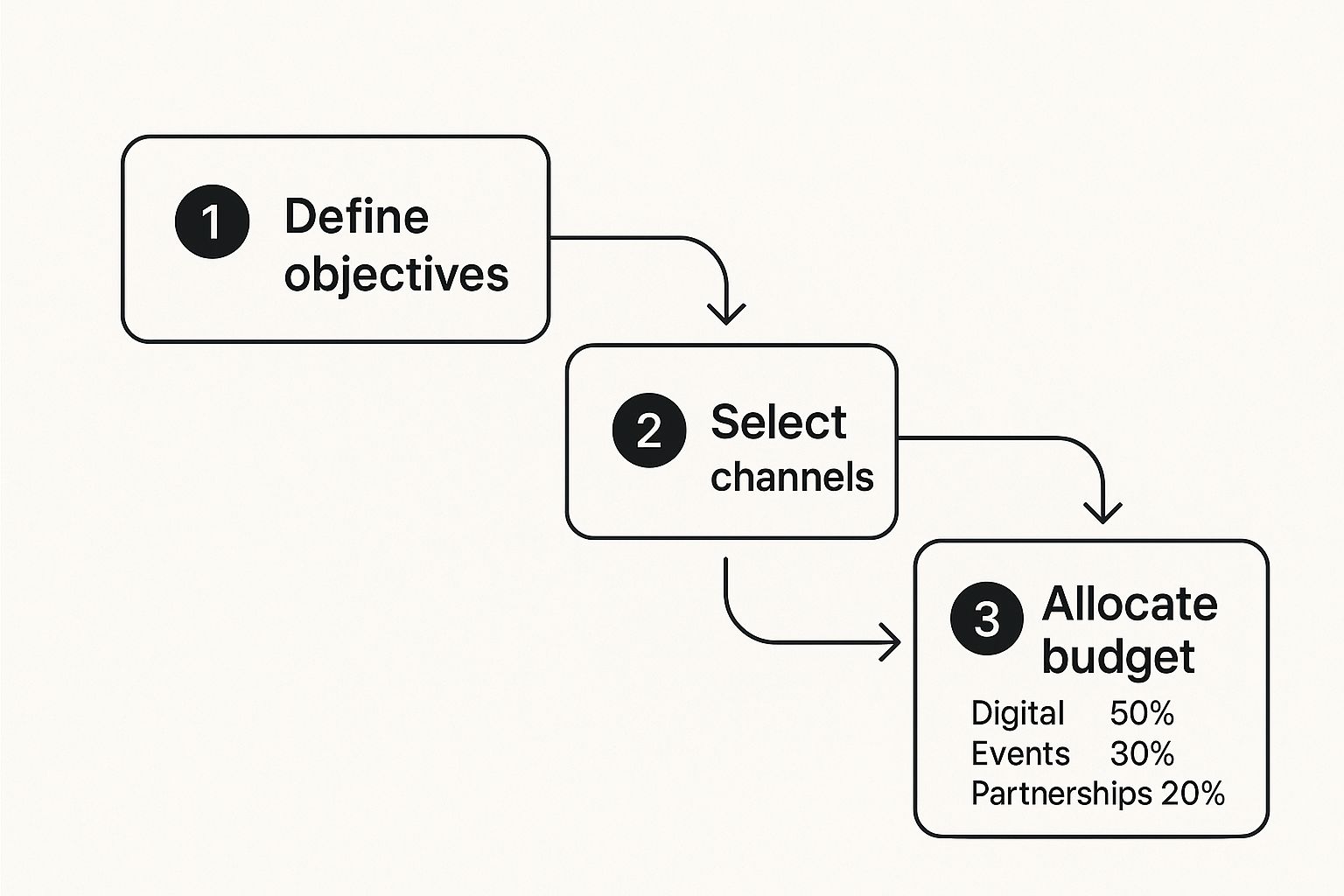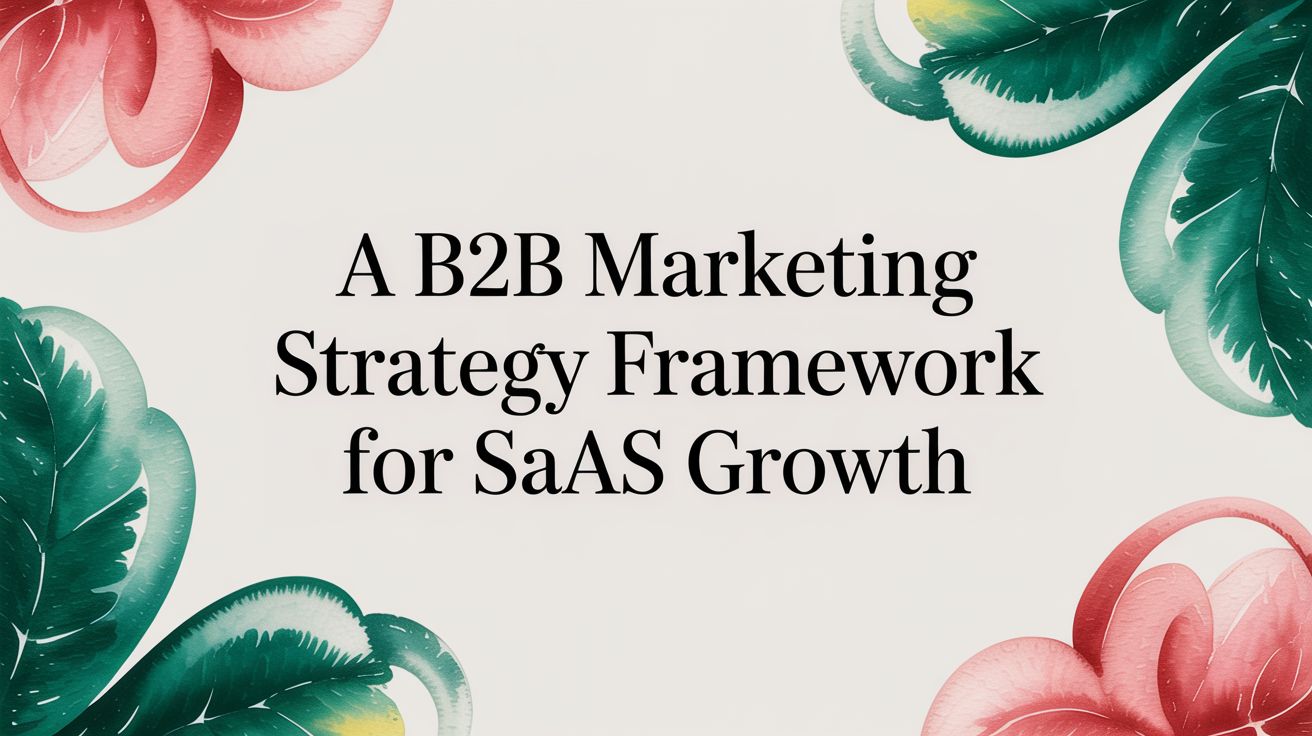Go to Market Strategy for Startups: Your Complete Guide
July 27, 2025

A go-to-market strategy for startups isn't just business jargon; it's the detailed playbook that connects your brilliant product to the people who will actually pay for it. Think of it as the bridge between a great idea and a real, thriving business. It meticulously maps out who you're selling to, where you'll find them, and how you'll convince them to choose you over everyone else.
Why Your Startup's Story Starts with a GTM Strategy
 Let’s be honest—that incredible product you’ve poured your heart and soul into? It’s only half the battle. The other, arguably more crucial half, is getting it into the hands of a market that is ready, willing, and excited to adopt it. This is where a go-to-market (GTM) strategy stops being a theoretical concept and becomes your most vital tool for survival.
Let’s be honest—that incredible product you’ve poured your heart and soul into? It’s only half the battle. The other, arguably more crucial half, is getting it into the hands of a market that is ready, willing, and excited to adopt it. This is where a go-to-market (GTM) strategy stops being a theoretical concept and becomes your most vital tool for survival.
Your GTM strategy isn't a static document you create once and file away. It's a living, breathing compass that guides every single decision you make—from who you hire for your first marketing role to how you structure your pricing. Without this compass, even the most groundbreaking products get lost at sea, running out of runway before they ever find land.
More Than Just a Plan, It's a Survival Guide
The startup world is notoriously unforgiving. The numbers don't lie: around 90% of startups ultimately fail. But the real kicker is why they fail. A staggering 42% of these failures are chalked up to building something with 'no market need'.
A well-researched GTM strategy directly confronts this number one startup killer. It forces you to validate your assumptions and prove a market exists before you burn through all your cash.
A GTM strategy isn't about avoiding all risks; it's about taking the right risks. It forces you to answer the tough questions early, transforming blind faith in your product into data-backed confidence in your business.
It’s important to distinguish this from a general marketing plan. Your GTM strategy is the high-level blueprint for winning a specific market. Your marketing plan, on the other hand, details the specific tactics—the channels, campaigns, and content—you'll use to execute that blueprint. To see how these pieces fit together, check out our guide on building a marketing strategy for startups.
The Core Pillars of a Winning Startup GTM Strategy
To craft a GTM strategy that actually drives growth, you need to build it on a foundation of several key pillars. Each one answers a fundamental question about your business and how it will compete. Think of them as the essential ingredients in your recipe for market success.
Here's a high-level look at these core components.
The Core Pillars of a Winning Startup GTM Strategy
By thoughtfully constructing each of these pillars, you create a cohesive and powerful narrative. It’s what aligns your product, marketing, and sales teams, ensuring everyone is pulling in the same direction with a single, unified goal: to win the market.
Building Your Foundation on Market Reality

Assumptions are the silent killer of startups. Every failed venture I've seen began with a founder who assumed they knew what customers wanted, what they’d pay, or how to reach them. A powerful go-to-market strategy isn't built on guesswork; it's built on the cold, hard reality of the market. This is where you trade wishful thinking for unshakeable conviction.
The good news? You don’t need a massive research budget to uncover the truth. You just need curiosity, a structured approach, and a genuine willingness to listen. The goal is to get inside your potential customers' heads and understand their world better than anyone else.
Decoding Your Ideal Customer
Before you can sell a single subscription, you have to know exactly who you're selling to. This goes way beyond basic demographics. You need to build an Ideal Customer Profile (ICP) and buyer personas that feel like real people with real problems.
An ICP defines the perfect-fit company for your B2B SaaS. Get specific and think about:
- Company Size: Are you targeting scrappy 10-person teams or complex 500-employee enterprises? The sales motion for each is completely different.
- Industry/Vertical: Which sectors feel the pain you solve most acutely? A generic solution rarely wins.
- Technographics: What other software do they already use? A company using Salesforce and HubSpot is a very different prospect than one still running on spreadsheets.
- Revenue & Funding: Does their financial status actually align with your price point? Don't waste time selling a premium product to companies with no budget.
Once you’ve defined the ideal company, it's time to map out the people inside. Who is your champion? Who holds the budget? Who will be the daily end-user? Give them names, job titles, and, most importantly, daily frustrations.
Your buyer persona isn't just a marketing exercise; it's a compass. Every piece of content you create, every feature you build, and every sales email you send should be directed at "Maria, the overworked marketing manager," not some vague, faceless company.
Uncovering Market Gaps Through Competitor Analysis
Studying your competitors isn't about creating a feature-for-feature checklist. It’s about dissecting their go-to-market motions to find exploitable weaknesses. Look past what they sell and focus on how they sell it.
- Analyze their messaging: What pain points do they hammer home constantly? Is their positioning weak or confusing anywhere?
- Dissect their content: Are they producing high-level thought leadership or tactical, how-to guides? Can you do better or serve an uncovered niche?
- Map their channels: Where are they spending their ad money? Maybe they dominate LinkedIn but are totally absent from relevant online communities where you could thrive.
This deep dive helps you carve out a defensible position in the market. Maybe your competitors all target enterprise clients, leaving a massive opening for a product tailored to mid-market needs. Or perhaps their product is powerful but notoriously difficult to use, creating a clear opportunity for a more intuitive, user-friendly alternative.
This initial research is a core part of the journey. In fact, a deep understanding of your customer is the very first step toward finding product-market fit. To dive deeper into that specific process, you can find a helpful guide on finding product-market fit for B2B founders on our blog.
High-Impact Research On a Startup Budget
Let's get practical. You need to validate everything with real-world data, but you can’t commission a five-figure market study. Here are a couple of low-cost, high-impact research methods I swear by for lean teams.
Become a Lurker (Then a Contributor): Find the online communities where your ideal customers hang out. This could be specific subreddits, LinkedIn groups, or niche Slack communities. For weeks, just read. Absorb their language, take note of recurring complaints, and see what questions pop up over and over.
Conduct Customer Discovery Interviews: This is non-negotiable. Find 10-15 people who fit your buyer persona and ask for 20 minutes of their time. The key is to listen, not pitch. Ask open-ended questions about their challenges and current workflows. You’ll be amazed at what you learn when you stop selling and start genuinely trying to help.
As you build this foundation, you'll need to think about how you'll attract customers. Understanding the nuances between demand generation versus lead generation is crucial for allocating your limited resources effectively. Your research will tell you whether you first need to create awareness and desire (demand gen) or capture existing intent (lead gen).
Crafting a Message That Actually Connects
 Once you have a crystal-clear picture of your ideal customer, the real art begins. This is where all that deep market research gets turned into a message that builds your brand and, more importantly, drives revenue.
Once you have a crystal-clear picture of your ideal customer, the real art begins. This is where all that deep market research gets turned into a message that builds your brand and, more importantly, drives revenue.
A powerful message does more than just list what your product does; it makes your audience feel seen and understood. It’s the core of any effective go to market strategy for startups—the story you tell, the promise you make, and the reason a customer picks you from a lineup of seemingly identical options. It’s what elevates a simple feature into an indispensable solution.
From Value Proposition to Unforgettable Story
Your value proposition is the logical core of your message. It’s a clean, straightforward statement explaining the tangible benefit you deliver. But a great brand story wraps that value prop in emotion and context, making it sticky and relatable.
Think of it like this: your value proposition is the what, and your brand story is the why. It’s the difference between saying "We sell project management software" and "We help growing teams reclaim their focus and do their best work, together."
To start weaving this narrative, frame it like a classic story:
- Who is the "villain" in your customer's world? Is it wasted time, fragmented data, or missed opportunities?
- How does your product transform them into the "hero"?
- What does the "happily ever after" look like for them once they’ve won?
This simple shift in perspective moves your messaging from features to transformation. It’s not about the tool; it’s about the better future the tool makes possible. For a deeper look at how messaging fits into the bigger picture, this guide on building a complete SaaS go-to-market strategy is a fantastic resource.
Defining Your Unique Selling Proposition
Your Unique Selling Proposition (USP) is the one powerful, defensible reason someone should buy from you and not your competitor. It’s the specific edge you own in the market.
Finding your USP requires some brutal honesty. It's not a wish list; it's a reality. It could be:
- A Laser-Focused Niche: You’re the only solution built from the ground up for independent architectural firms.
- Superior User Experience: Your competitors might be powerful, but they're clunky. Your product is intuitive and genuinely enjoyable to use.
- An Unbeatable Pricing Model: You offer a transparent pay-as-you-go model in an industry choked by expensive, opaque annual contracts.
Your USP should never be a laundry list of features. It must be a single, compelling idea that you can deliver on every single day.
A classic startup mistake is trying to be everything to everyone. A strong USP often emerges from radical focus. By choosing exactly who you serve, you make it incredibly easy for that specific group to see you as their only logical choice.
Building a Cohesive Messaging Hierarchy
With your core story and USP locked in, the next step is to translate them into a practical messaging hierarchy. This is what ensures consistency across every single touchpoint, from your website’s H1 tag to a single tweet.
A simple, effective hierarchy looks something like this:
This structure ensures that even your most granular pieces of copy reinforce your overarching brand story. It creates a seamless experience that builds trust and makes your startup feel established and professional, long before you are. Ultimately, your message becomes your most powerful asset for connecting with customers and carving out your space in the market.
Choosing Your Channels for Maximum Impact
You’ve got a magnetic message and a crystal-clear picture of your customer. Now for the million-dollar question: where do you actually show up? Deciding where to invest your limited time and money is every bit as important as what you have to say when you get there.
This isn’t about chasing every shiny new channel that pops up on your feed. A classic founder mistake is spreading their budget and focus too thin across a dozen platforms, just hoping something sticks. It’s a recipe for burnout and mediocre results.
A much smarter approach? Pick two or three channels where your ideal customers are highly concentrated. Go deep, learn the nuances, and aim to dominate that specific space before even thinking about expanding.
The B2B Channel Hierarchy
While the channel landscape can feel overwhelming, data gives us a clear starting point. For most B2B SaaS startups, there's a definite hierarchy showing where marketing dollars tend to flow, and for good reason.
When you look at B2B advertising budgets, Google commands 52%, with LinkedIn pulling in 32% and Facebook getting 11%. This tells a story: B2B buyers are found on professional networks and high-intent search platforms. Yet, a surprising 59% of companies admit to underinvesting in their product launches—over half spend less than $20,000.
This reveals two critical things:
- Your buyers are congregating on a few key platforms.
- Many of your competitors aren't budgeting enough to reach them effectively.
Your job is to be smarter than them.
Matching Channels to Your Strategy
The right channel for your startup depends entirely on your ICP, the complexity of your product, and your budget. To make sure your message hits home, it's vital to align your channel choices with effective B2B sales lead generation strategies from the very beginning.
Here’s a practical way I like to think about the options:
For High-Intent Buyers (The "Hunters"): If you solve a known, painful problem that people are actively searching for, Google Ads is non-negotiable. You’re simply capturing demand that already exists. This is the go-to for products in established categories where people know what to type into the search bar.
For Passive Prospects (The "Farmers"): What if your product introduces a completely new way of working? Potential customers won't know to search for you because they don't know a solution like yours exists. This is where channels like LinkedIn Ads and highly targeted content marketing shine. You're not capturing demand; you're creating it by educating the market.
For Community-Driven Engagement: If your ICP lives and breathes in specific online forums, Slack groups, or niche subreddits, direct engagement can be incredibly powerful. This is a "sweat equity" channel. It takes time and genuine participation, but it builds trust and authentic relationships long before you ever ask for a sale.
Your channel strategy shouldn't be a static choice. It's a series of experiments. Start with a primary channel based on your ICP and a secondary channel to test. Measure everything, double down on what works, and ruthlessly cut what doesn't.
Budgeting for Your Launch
Allocating a budget can feel like a shot in the dark, but we can bring some much-needed structure to it. Instead of plucking a number out of thin air, let's work backward from your actual business goals.
Define Your Target: First, what does success look like? Let's say you need to acquire 50 new customers in the first six months to validate your business model.
Estimate Your Funnel: Now, be realistic. Based on industry benchmarks, how many leads do you need to generate to land one paying customer? If your lead-to-customer conversion rate is a reasonable 2%, you'll need 2,500 leads to hit your goal.
Calculate Your Cost Per Lead (CPL): Do some research on your target channels. If a realistic CPL on LinkedIn for your industry is around $80, the math is straightforward. Your total marketing budget to acquire those leads would be $200,000 (2,500 leads × $80/lead).
That number might seem daunting, but it grounds your strategy in reality. It forces you to ask the hard questions: Is our target of 50 customers realistic for this budget? Can we find ways to improve our conversion rate? Should we start with a lower-cost channel to get our feet wet?
This exercise isn't about setting a rigid budget in stone. It's about understanding the financial mechanics of your growth engine. Your channel choices and your budget are inextricably linked—get them right, and you’ll build the momentum needed to truly take off.
If you want to go deeper on this, check out our full guide on building a B2B marketing channel strategy.
Executing Your Launch and Building Momentum
Strategy without execution is just a beautiful dream. This is where all your meticulous planning—your deep research, dialed-in messaging, and channel choices—finally translates into real-world market traction.
A great launch isn't a single, explosive event. It’s a carefully sequenced process designed to build buzz, gather critical feedback, and create unstoppable forward motion. The goal isn't just to announce your arrival; it's to create a gravity well that pulls in your first, most vital users—the ones who will become your evangelists. This is where the rubber meets the road.
The Phased Rollout Approach
Instead of a single "big bang" launch that puts immense pressure on your team and product, I always recommend a phased approach. This method de-risks the entire process and allows you to build momentum organically. It’s about starting small, learning fast, and scaling what works.
Here’s what a typical phased sequence looks like in practice:
Private Beta (The Inner Circle): Start by inviting a small, hand-picked group of your ideal customers. These are your "friendlies." The goal here isn't revenue; it's high-quality, candid feedback. You want them to find bugs, validate your workflows, and confirm that your value proposition truly resonates before you face the wider market.
Waitlist Launch (Building Anticipation): Once the product is stable and you've incorporated the initial feedback, open a public waitlist. This is a classic tactic for a reason—it works. It creates scarcity and social proof. Promote the waitlist on your chosen channels and consider offering a small incentive for early sign-ups, like a first-month discount or exclusive access to a future feature.
Public Launch (Opening the Floodgates): This is your main event. With a polished product and a list of eager users, you can now execute your full marketing plan. Coordinate your efforts across all channels to maximize your impact on day one.
This is a simple framework for thinking about how to allocate resources as you move from one phase to the next.

As the infographic shows, it’s a clear, three-step process for budget allocation, ensuring your spending is directly tied to your strategic objectives and channel selection at each stage.
Securing Early Wins and Social Proof
Your first users are so much more than just customers; they are your most powerful marketing asset. The social proof they provide is invaluable for convincing the next wave of users to sign on the dotted line. You have to make it a priority to capture their excitement and turn it into compelling testimonials and case studies.
Don't just sit back and wait for users to offer testimonials. You have to actively seek them out. The moment a user gives positive feedback via email or support chat, ask them right then and there if you can share their quote. Most happy customers are delighted to help.
As you start executing, a solid lead generation strategy is what will keep your sales funnel full. Mastering the fundamentals of attracting and converting leads is absolutely essential for building on your initial launch momentum. If you're looking to sharpen your skills, there are excellent resources on Lead Generation Best Practices that can give you a real edge.
Leveraging Data and Personalization
Modern GTM execution is powered by data. It’s that simple. Startups that lean into AI and data-driven personalization gain a massive advantage right out of the gate.
The latest trends are clear: companies that incorporate multi-sourced intent data into their GTM processes see a 25% increase in pipeline conversion rates. What's more, an incredible 80% of marketers report better customer engagement when they use AI-driven personalization.
This isn't about some far-off future. This means using tools today to understand user behavior within your product, personalizing your onboarding flows, and triggering targeted email campaigns based on what users do (or don't do). This level of personalization makes users feel seen and guided, which dramatically increases the odds they'll stick around for the long haul.
Ultimately, launching is just the beginning. The real work is in sustaining that initial burst of energy and turning it into a growth flywheel. For a comprehensive look at how these launch tactics fit into a larger framework, our B2B marketing playbook for startups offers a detailed roadmap for long-term success.
Founder GTM FAQs: The Tough Questions Answered
Look, even the most buttoned-up GTM plan hits the real world and gets messy. That's not just okay; it's expected. Founders are constantly wrestling with the same core uncertainties around timing, scope, and when to pivot. These questions aren't a sign you're on the wrong track—they’re a sign you’re in the thick of it, building something from scratch.
So let's get into the questions we hear constantly from founders deep in the trenches of building a go to market strategy for startups. The goal here is simple: clear, direct answers to help you stop second-guessing and start moving forward.
How Often Should We Revisit Our GTM Strategy?
Your GTM strategy isn't a stone tablet you carve once and worship forever. It’s a living document. For an early-stage startup, that means you need to be in a constant state of review and adaptation.
Think of it this way: you should conduct a major, deep-dive review quarterly. But you have to be ready to make tactical shifts monthly, or even weekly, as the data rolls in. The market won't wait for your scheduled meeting.
What should trigger a review?
- You're missing your numbers. If lead or customer acquisition goals are consistently a miss, something is fundamentally broken in your strategy.
- The market is talking back. Are prospects and early users constantly bringing up a pain point you missed? Or questioning your core value? It's time to listen, hard.
- A competitor makes a big move. If they launch a killer feature, pivot into your niche, or slash their pricing, you can't afford to ignore it. You have to reassess your position immediately.
- You just raised a new round. Fresh capital completely changes the game. The scrappy strategy that got you here isn't ambitious enough for where you need to go next.
Don't fear iteration. Embrace it. We’ve seen successful companies change their core GTM motion five to seven times before landing on a truly scalable model. Every pivot is a lesson that makes your strategy stronger.
GTM Strategy vs. Marketing Plan: What’s the Difference?
This is one of the most common points of confusion we see, and getting it right is critical for how you spend your time and money. They’re connected, but they are absolutely not the same thing.
Your Go-to-Market Strategy is the high-level blueprint. It’s the "who, what, where, and why" of your entire commercial effort. It answers the big questions: Who are we selling to? What problem do we solve? Where will we win? Why will we beat the alternatives?
Your Marketing Plan is the tactical execution layer of that strategy. It’s the "how" and "when." It's the specific list of actions, campaigns, and content your team will execute to bring the GTM vision to life.
Here's how it breaks down in the real world:
Your GTM strategy sets the destination. Your marketing plan is the turn-by-turn navigation to get there.
Can We Launch Without a “Perfect” GTM Strategy?
Yes. In fact, you have to.
The pursuit of the "perfect" GTM strategy is a classic startup trap. It leads to analysis paralysis, which will kill your company faster than any competitor. Your first GTM is nothing more than your best-educated guess—a set of hypotheses that need to be tested against reality.
The goal isn't perfection; it's clarity. You need a framework that's just "good enough" to get your team aligned, focus your initial efforts, and give you a baseline to measure against. The single fastest way to get smarter is to launch and let the market start replacing your assumptions with cold, hard data.
A good-enough strategy that gets you out the door and learning is infinitely more valuable than a theoretically perfect one that never leaves the spreadsheet. Your real, battle-tested GTM strategy will be forged in the fire of execution, not dreamed up in a conference room.
Navigating these questions is what being a founder is all about. At Big Moves Marketing, we provide the fractional CMO expertise B2B SaaS startups need to turn these strategic questions into confident, decisive action. If you're ready to build a GTM strategy that drives real growth, let's talk. Learn how we accelerate growth for startups like yours.
%20-%20Alternate.svg)


%20-%20white.svg)